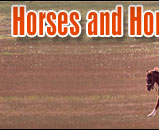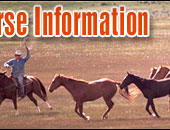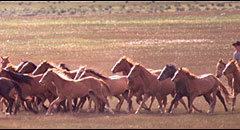 |
   |
|
|
|
You are here: Horses > Horse care > Horse Blankets |
Why Not All Equines Need a Winter Horse Blanket -
Stable Blankets Can Make Some Horses Colder in the Winter.
When the cold winter weather hits, many horse owners
automatically bring out the horse blankets. However, a
horse’s normal winter coat is much more insulating than a
blanket, and unless the horse has been clipped, is outside
without a windbreak, or has been moved to a colder climate
during winter months, it will usually actually be warmer
without a blanket. |
|
|
The longer winter coat helps to trap the body heat against
the skin. Also, tiny muscles in the skin raise the hairs,
creating tiny air pockets that heighten the insulating
effect. Flatten this ‘fluffed-up’ coat by adding layers of
light blankets, or even one heavy one, can actually make the
horse colder. If a horse is not accustomed to being
blanketed, it can put the horse at increased risk. If it
becomes overheated, it will begin to sweat. The dampness
causes it to become chilled later, which then increases the
risk of |
pneumonia or other respiratory infections. If a horse must be blanketed
in the colder temperatures of morning, make sure that you or
another responsible hand is there to take the blanket off
when temperatures rise later in the day.
 Therefore, it is important to choose a blanket that is
appropriate to how much extra protection from the weather
that the horse genuinely needs. Modern blankets are much
warmer and resistant to weather than traditional wool
blankets, using inner and outer shells with an insulating
fiber between. Outer shells are usually made of synthetics
which are water repellent and windproof, while the inner
lining is smoother than wool so it won’t chafe against the
horse’s skin. The filling between them provides warmth with
much less bulk than older blankets. This means the overall
blanket is light enough not to flatten the horse’s coat, and
is more durable than their wool or cotton predecessors. Therefore, it is important to choose a blanket that is
appropriate to how much extra protection from the weather
that the horse genuinely needs. Modern blankets are much
warmer and resistant to weather than traditional wool
blankets, using inner and outer shells with an insulating
fiber between. Outer shells are usually made of synthetics
which are water repellent and windproof, while the inner
lining is smoother than wool so it won’t chafe against the
horse’s skin. The filling between them provides warmth with
much less bulk than older blankets. This means the overall
blanket is light enough not to flatten the horse’s coat, and
is more durable than their wool or cotton predecessors.
The outer shells, made of nylon fiber, will not snag or tear
and are treated to be waterproof, which also makes them
resistant to rot and mildew. This waterproofing also helps
to hold heat in, but in the most extreme cold, the coating
might crack. Foam particles or fiberfill usually make up the
filler due to their insulating properties, without weight.
Making sure that the blanket fits the horse properly is
important, regardless of the blanket type. One that is too
tight will irritate the skin and put the horse at risk of
developing abrasions and sores, while a blanket that is too
large can slip down under the horse’s belly. Not only will
that result in the loss of almost all the blanket’s
insulating ability, if the horse gets its legs tangled in
the blanket’s straps, it can be seriously injured. Putting
the blanket on properly also helps to ensure a good fit. Put
it on well forward, then slide it gently back into position
to keep it from pulling the coat the wrong way.
Each horse should have its own blanket. Sharing blankets can
facilitate the spread of skin problems such as girth itch,
ringworm, and other fungal infections. Even if no horses in
the stable have known skin problems, fungal spores can cling
to the blankets and be spread to other horses. The blankets
should be washed if they are used often during the winter,
at least twice, using cold water and a disinfectant soap.
Rinse the blankets well to make sure that no soap residue
remains to irritate the horse’s skin.
Cold water washing is preferable to dry cleaning. Dry
cleaning will not remove odors, and the heat and chemical
solvents can dissolve the waterproofing and shrink the
bindings.
 |
Read the next horse care article on Grooming, Brushing and Cleaning. |
|
|
|
|
 |
|
|
 |
 |
  
Visit Equestrian Cupid now.
The best and largest equestrian club for meeting the other half for friendship and marriage
|
|
 |
|
|
|
Horse Education
|
|
|
|
|
Horse Information Topics
|
|
|
|
|
|
|
|
Horse Business Owners
|
| |
Advertise with Us
Have your horse products or services exposed to over 27,000 of our monthly visitors.
|
|
|
|
|
|